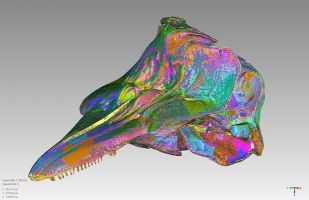For over 12 months now, the Geomagic team has been advising and watching as the team at Idaho State University's Virtualization Lab went full bore into creating 3D data out of natural history subjects: whale skeletons, dolphin skeletons, fossils and more.
 As the team, headed by Dr. Herbert Maschner, built up its 3D inventory, so they have been making the model data available for schools worldwide at ivl.imnh.isu.edu.
As the team, headed by Dr. Herbert Maschner, built up its 3D inventory, so they have been making the model data available for schools worldwide at ivl.imnh.isu.edu.
But how is that 3D data created? The team travels to locations where a desired skeleton is housed or sometimes performs scans at the lab. The team, managed by Robert Schlader, photographs the bones, and then selects from a range of scanners, including two FARO Edge scanners, a FARO Focus, Minolta VIVID 9i, NexEngine 3D scanner HD, Cyberware Model Shop and Cyberware Desktop. (Image above: Harbor porpoise skull (USNM-571765) in Geomagic Studio)
The scan data is put into Geomagic Studio to be processed into usable 3D models; the software automates the process of filling remaining holes, removing intersecting polygons, and clearing vertex color data. Saving out the data to 3D PDF both as high and low-resolution models, the files are then accessed by schools worldwide.
Click here to see this story in a longer, more detailed version in Computer Graphics World.